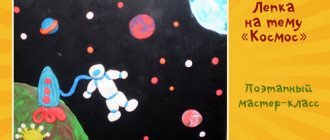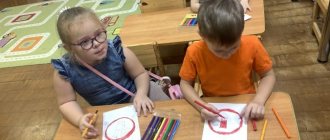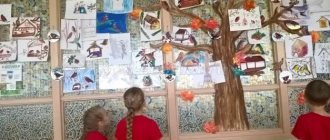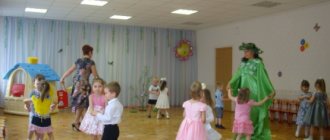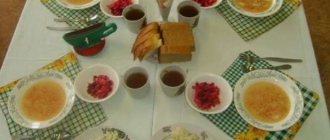Holiday for school children
Goals of the holiday dedicated to Cosmonautics Day:
- Tell schoolchildren about Cosmonautics Day, teach them to formulate their thoughts;
- Explain what goodness, valor, courage, bravery are, who heroes are, and for what merits they are worthy of respect;
- To give an idea of what the planets of the solar system are called, where they are located, what their features are;
- Develop intellectual and creative abilities, teach logical thinking.
To the song “March of Young Cosmonauts,” schoolchildren enter the music room.
Leading:
Dear guys, we are at the cosmodrome. In a few minutes our ship will go into space. How many of you know what holiday is celebrated in many countries on April 12? (Children answer)
Leading:
It was on April 12, 1961 that man first began to conquer space. And this was our compatriot, Yuri Gagarin. Surely, this name is known to each of you. For Cosmonautics Day, we have prepared an exciting trip for you. First we will go back in time to find out how Gagarin lived. Surely, each of the boys present here dreamed as a child of flying into space. Raise your hands, who wanted to become an astronaut? Previously, only a few could become an astronaut, but now, if they wish, many will be able to fly into space. On April 12, 1961, Soviet cosmonaut Yuri Alekseevich Gagarin made his first flight around the Earth.
Next comes watching a film about Yu.A. Gagarin.
You can take a children's film, which we have already suggested above in the script for kindergarten, for older schoolchildren (who no longer get tired quickly), you can show this film or any other:
Leading:
Now let's go with you into space. Surely everyone wants to look at mysterious and enigmatic cosmic phenomena?
If you really want to become an astronaut, you must prepare and know a lot. Any space route is open to those who love work. Only a friendly team will fly into space, Sad and gloomy, you are not on our way.
Leading:
This is the first planet we will stop on. Let's tell poems about space, perhaps the planet will like them, and it will welcome us hospitably.
Children recite poems. For example, these:
All the planets in order (Arkady Khait)
In order, all the planets can be named by any of us: One - Mercury, Two - Venus, Three - Earth, Four - Mars. Five is Jupiter, Six is Saturn, Seven is Uranus, followed by Neptune. He is the eighth in a row. And behind it, then, is the ninth planet called Pluto.
*** (Andrey Usachev)
An astrologer lived on the Moon. He kept track of the planets: MERCURY - one, VENUS - two, three - EARTH, Four - MARS, Five - JUPITER, Six - SATURN, Seven - URANUS, Eight - NEPTUNE, Nine - the farthest PLUTO, Who If he doesn’t see it, get out!
*** Saturn (Rimma Aldonina)
Each planet has something of its own, which most clearly distinguishes it. You will certainly recognize Saturn by sight - It is surrounded by a large ring. It is not continuous, it is made up of different stripes. Here's how scientists solved the question: Once upon a time, water froze there, And Saturn's rings were made of snow and ice.
Leading:
Now let's play an interesting game. I will ask a riddle, the answer to which lies in my mysterious box.
- There is a bright yellow circle in the sky, And the rays are like threads. The Earth revolves around, As if on a magnet.
The presenter takes out the sun from the box after the children solve the riddle.
- A man sits in a rocket, takes off, is not afraid, and in his big spacesuit he is almost like a bird. (Astronaut).
- I have a blue ball in my hand, on it there are mountains, rivers, volcanoes in the distance. There are both you and me on it, What kind of planet is this? (Earth).
You can show this video:
Leading:
Well done guys, you solved all the riddles. Now let's play the game "Flies or doesn't fly" (suitable for preschoolers and elementary school students). If I name an object or an animate creature that can fly, you raise your hands up. If what I call can’t fly, don’t raise your hands.
- Can the plane fly?
- Can a hippopotamus fly?
- Does the rocket fly?
- Does the table fly?
- Does the helicopter fly?
- Does the quadcopter fly?
- Does a cow fly?
Leading:
What great fellows you are, you all know who flies and who doesn’t. And you probably know which planets are adjacent to our Earth.
Teachers or high school students dressed as planets come out to the music. The presenter briefly talks about each planet.
Leading:
All planets are beautiful, but the most amazing and beautiful is our planet Earth.
A master class is being held in which schoolchildren make models of the Earth from salt dough.
Leading:
Well, our excursions to the planets and space have come to an end. We flew with pleasure, but with even greater joy we return to our home - our beloved planet Earth.
First student:
Here the sky is blue and the sun is shining brightly. Both adults and small children are happy here.
Second student:
We can’t count all the miracles, there is still one name, Mountains, deserts and seas, all this is our beloved Earth!
Leading:
Dear friends, we have returned to our home planet. Our journey is over and we hope you enjoyed it. See you again!
At the end of the event, you can all sing together a song about space, “Interplanetary Cruiser.”
Lyrics:
The amazing is nearby In the galactic window, We look at it, rubbing our eyes against the pipe. We are waiting for a lesson like an eclipse, We will make a foray into space, For an unknown zeal Man has been searching since childhood.
Interplanetary cruiser, astronaut and dreamer. Our teacher is an astronomer, Our school is a cosmodrome. Interplanetary cruiser, astronaut and dreamer. Our teacher is an astronomer, Our school is a cosmodrome.
Curious people are everywhere, We don’t hide our appetite, We know there will be a meeting with something new, Someone will fly to the stars. In the meantime, we want an eclipse, From star to star, a lesson in Interplanetary approach, If only chance would help us.
Interplanetary cruiser, astronaut and dreamer. Our teacher is an astronomer, Our school is a cosmodrome. Interplanetary cruiser Astronaut and dreamer. Our teacher is an astronomer, Our school is a cosmodrome.
The format of the holiday can be any, the main thing is that the children find it interesting and not boring. You can add various sports and creative competitions, conduct educational lectures in a playful way, and award symbolic prizes.
We bring to your attention a selection of videos of children's parties for Cosmonautics Day (I am sure that you will also get a lot of ideas from them):
A fairy tale for Cosmonautics Day for elementary school children
Theatrical production “The Tale of a Comet” on Cosmonautics Day for primary schoolchildren
Goal : the opportunity to emancipate students through theatrical activities. Objectives: • Explain the concept of “Theater” • Develop speech by introducing new words • Form semantic memory When you look into the sky during the day, you see our star named the Sun there, when you look at night, you can see many celestial bodies and other phenomena there – The moon, stars, constellations, nebulae, the Milky Way... Sometimes stars - meteorites - fall, and then you can make a wish - it will definitely come true.
And very rarely you can see a most beautiful phenomenon - a bright star with a long tail - a comet - flashes across the night sky. Once upon a time there lived a comet named Tail.
She had a pretty green head with an elegant crown and a long motley tail made of many beautiful pebbles, which rushed behind her everywhere, fluttering and blossoming like a peacock (prepare a multi-colored wig, a crown, and pebbles on the headbands)
.
The Sun (prepare a solar outfit for the Sun)
loved Tail very much, and she happily returned to him sometimes, but Tail loved flying even more in the vastness of space far, far beyond the sunny house.
She quickly rushed past the planets living in the solar house - Mercury, Earth, Venus, Mars and others, even more distant ( prepare clippings with images of the planets)
.
The planets admired their beautiful sister and were a little jealous of her freedom. After all, they had been walking around the Sun a long time ago in their tight orbits and could not do it any other way. But this freedom was not enough for Tail. She wanted to fly away completely and become completely free. And she began to try to fly away from her usual orbit around the Sun. And as soon as she tried to do this, she stumbled into an invisible wall (several people)
and hurt herself so painfully that her crown flared up brightly and her head almost burned out.
And several pebbles flew out of the wall and were added to Tail. Now Tailtail has become larger and heavier, and it has become more difficult for her to fly. But she did not give up her attempts to break out of the usual flight circle. And she hit the invisible wall again, even stronger than before. And again, from a strong blow, her crown and head flared up, and many stones flew out of the wall, making the Tail even heavier. She now hardly flew her next revolution around the Sun. As she flew past small, fast Mercury, he asked her: “What’s wrong with you, Ponytail?” Why do you fly with such difficulty, and why has your crown become so small and your tail so large? Ponytail answered him: “I wanted to fly wherever I wanted, but I kept running into some very strong wall.” It made my tail so heavy and my crown small. Mercury was surprised: “I’ve been flying around the sun for a very long time and have never heard of such a strong wall.” Maybe Sister Venus knows? Ponytail flew past Venus and asked her: “Dear sister, don’t you know about the Heavenly Wall that doesn’t let me go free?” Beautiful Venus shook her curly head and answered that she had never encountered this wall and had never even heard of it. Maybe the next sister is Earth. As Tailtail flew past the blue-green Earth, she asked her if she knew anything about the Sky Wall. The Earth yawned and replied that it had a lot of worries even without Tail, but perhaps the small creatures living on it since recent times know something about this. They are called astronomers (select several people)
because they love to spy on the stars.
They have magical transparent stones in long tubes, telescopes, through which they look into the sky (roll up several tubes from paper)
.
Ponytail asked the astronomers if they had seen the Sky Wall with their telescopes. The astronomers shook their smart heads and said that they had seen all her sisters and brothers and many more stars in space, but they had not seen any wall through their telescopes. Mars also didn’t know about the wall, but said that he used to have a neighbor and brother named Phaethon, and he, on the chariot of their father, the Sun, wanted to rush across the sky and surprise everyone, but due to Phaethon’s inexperience, the chariot crashed and now Shards of the chariot spin around the Sun. Ponytail thought for a while and flew on. At the very edge of the solar house lived Saturn, Neptune and Uranus. These were gray-haired old men (they need to make beards)
, who had seen a lot in their lifetime.
But they also knew nothing about the Heavenly Wall. Only Uranus said to the small comet with a green head: “Be careful, sister.” Anyone who strays from the proven path is at great risk. We have all stopped taking risks for a long time and have been going back and forth along the same route year after year, which is why we are still safe. Ponytail listened and told him: “Goodbye, brother!” I'll try again, and come what may! She rushed with all her might and hit the Wall. Pluto saw how the green head of the Tail and its entire motley beautiful tail hit an invisible barrier and crumbled into thin shimmering dust, which spun in a corkscrew, and the solar wind scattered it in a wide strip across the entire sky - the Milky Way appeared on it (line up the guys in disarray and prepare pieces of glitter)
. This is a heavenly river of milk, it contains everything that the comet Tail saw during its travels and the great Wall of Heaven knew: moonlight and the conversation of the constellations, and the sound of the solar wind, and the smell of bells, and the ringing of spring drops, and the chirping of grasshoppers and the warmth of the native at home... ... It was a long time ago. Since then, any person admires this beauty, looking at the Milky Way, but knows nothing about the small green comet that flew away from its home.
We recommend watching:
Scenario of an extracurricular event in an elementary school on the topic: Cosmonautics Day Intellectual tournament for Cosmonautics Day, 4th grade Sports game in an elementary school on Cosmonautics Day. Scenario Crossword clue Space for Cosmonautics Day with answers for grades 3-4
Similar articles:
Extracurricular activity for Cosmonautics Day in primary school
Extracurricular activities April 12 - Cosmonautics Day. Scenario for 4th grade
Methodological development of a class hour for Cosmonautics Day for 3rd grade
Competitions for Cosmonautics Day for primary schools
Riddles about the sky and stars with answers for children

